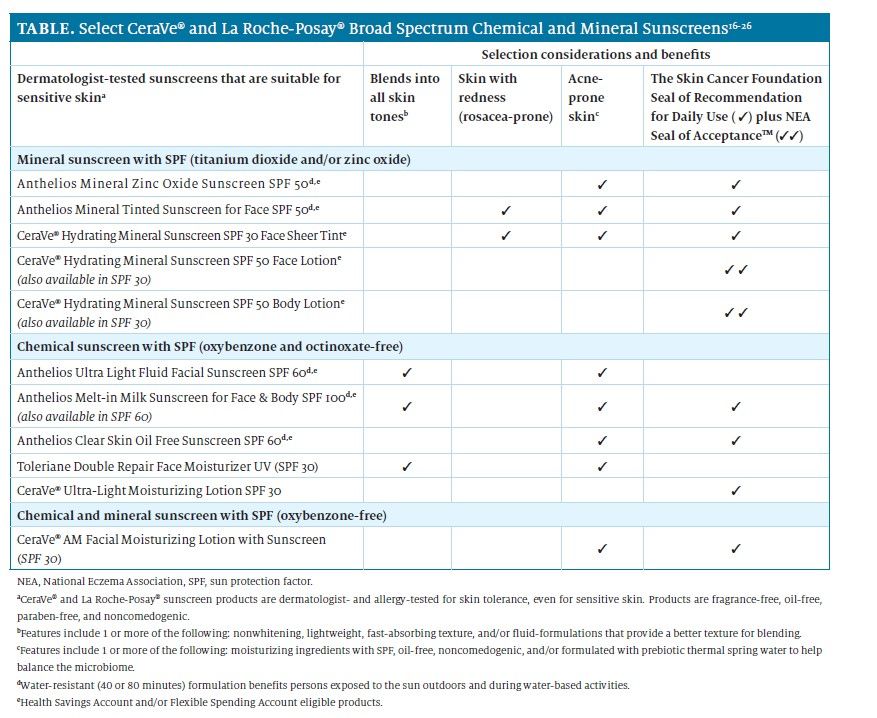Article
Guide to Preventative Skin Care and Importance of Sun Protection for the Community Pharmacist
This article was sponsored by CeraVe® and La Roche-Posay®.
Not all populations have access to regular dermatologist visits for education, preventative care, and skin cancer–risk screening. One in 5 Americans will develop skin cancer by the age of 70 years.1 Given this high prevalence of skin cancer, pharmacists have an impactful role—to take action within the community, incorporate screening for skin cancer risk, and educate the public concerning the need for photoprotection.1 The Skin Cancer Foundation recommends sunscreen application as an effective aid in preventing sun-induced damage to the skin, including sunburn and possible premature aging. When used regularly according to label directions, certain products may also help reduce the potential risk of skin cancer due to overexposure to sunlight.2
SKIN CANCER PREVENTION IN THE PHARMACY
Skin cancer affects people of all skin types. The Fitzpatrick system classifies skin type based on how much pigment is found in the skin and how the skin reacts to exposure to the sun:3,4
- type I: always burns, never tans (palest; freckles);
- type II: usually burns, tans minimally (light colored,
but darker than fair); - type III: sometimes burns mildly, tans uniformly (golden honey or olive);
- type IV: burns minimally, always tans well (moderately brown);
- type V: very rarely burns, tans very easily (dark brown); and
- type VI: never burns (deeply pigmented dark brown or black).
Anyone can develop skin cancer, but established factors (eg, type I and II classification, having > 50 moles, a family or personal history of skin cancer) put individuals at a greater risk.5-7 Additionally, certain medications may cause the skin to be more sensitive or to react unusually to UV-A/UV-B light exposure (ie, photosensitivity).8
There is a lack of identification and recognition of skin cancers in people with skin types IV to VI. Educational materials for both patients and health care professionals traditionally demonstrate images with examples of basal cell carcinomas on skin types I to III.9 As 50% of basal cell carcinomas are pigmented brown in color, skin cancer warning signs often go undetected because they look different on darker toned skin. As a result, skin cancer is often diagnosed too late and at a stage that is difficult to treat in people with a darker skin tone.10-12
Pharmacists can play a major role in education, especially as it relates to addressing individual skin care needs, preventing skin cancer across all skin types, and guiding the selection of broad spectrum sun protection products available in the pharmacy.
PHOTOSENSITIZING PRESCRIPTION MEDICATIONS
Several photosensitizing prescription medicationsare dispensed regularly in the pharmacy, like acne medications (eg, doxycycline, spironolactone, oral contraceptives, topical retinoids, isotretinoin), antibiotics (eg, tetracyclines, sulfonamides), and hormonal contraceptives.8,13,14 Commonly used OTC medications can also be photosensitizing such as nonsteroidal anti-inflammatory drugs (particularly naproxen).14
Skin photoprotection is top of mind during the warm weather seasons, but there are several opportunities for pharmacists to advocate for protection year-round. When dispensing prescription photosensitizing medications, pharmacists can recommend broad spectrum sunscreen products. As photosensitizing acne medications with isotretinoin can cause skin drying effects, pharmacists can suggest sunscreen products with added hydrating ingredients.15
BROAD SPECTRUM SUN CARE WITH CERAVE® AND LA ROCHE-POSAY®
The Table contains information to support education concerning select CeraVe® and La Roche-Posay® broad spectrum sunscreens.16-26 These sunscreen products are formulated for sensitive skin types, offer a range of sun protection factor (SPF) values for individual needs, and contain ingredients that provide additional benefits (eg, ceramide, antioxidants, hydrating ingredients).

CeraVe®
CeraVe® sunscreens are developed with dermatologists; they are the only 100% mineral-based sunscreens that contain 3 essential ceramides (ceramides 1, 3, and 6-II) to form a protective barrier on the skin’s surface to avoid irritation of sensitive skin and to lock in moisture after application.27 Moisturizing ingredients are provided to the skin’s surface through a time-released, multivesicular emulsion technology that delivers concentric layers of oil-in-water emulsions. These layers slowly unfold upon application, continually releasing ingredients for the skin to absorb, as needed. These ceramide-containing sunscreens are formulated to help maintain and restore the skin’s natural protective barrier against damage induced by UV radiation.28
Ceramides are lipids found naturally in the skin; they make up 50% of the stratum corneum. They are essential to support the skin barrier and retain moisture. When ceramide levels are low, the skin barrier is weakened, and moisture can escape. Ceramide deficiency is associated with atopic dermatitis, acne, and other dermatologic conditions.29,30 Additionally, people with skin types IV to VIhave ceramide deficiencies, and they may benefit from ceramide-containing formulations.31
CeraVe®AM Facial Moisturizing Lotion with Sunscreen (SPF 30) and CeraVe® Ultra-Light Moisturizing Lotion SPF 30 are lightweight daily moisturizers with chemical SPF filters, which tend to be easier to rub into the skin and less likely to leave a white residue.32
La Roche-Posay®
La Roche-Posay®’s Anthelios has several sunscreen products available aimed to meet the needs of all ages, skin types, and tones, such as Anthelios Melt-in Milk Sunscreen for Face & Body SPF 60 and Anthelios Mineral Tinted Sunscreen for Face SPF 50. Anthelios sunscreen products are formulated with Cell-Ox Shield® technology, which combines photostable UV-A/UV-B filters (eg, avobenzone, homosalate, octisalate, octocrylene) plus antioxidants (eg, vitamin E, vitamin C, senna alata) to defend skin cells against damaging free radicals caused by exposure to UV rays and the environment.33-35
Increasing evidence suggests that the skin microbiome may play a role in atopic dermatitis, psoriasis, and acne.36,37 Toleriane Double Repair Face Moisturizer UV (SPF 30) is formulated with La Roche-Posay® Prebiotic Thermal Spring Water to help foster a balanced skin microbiome.36 This core ingredient contains a combination of minerals, trace elements, and a high concentration of the natural antioxidants selenium and strontium that help soothe skin.36
For a description of the ingredients in CeraVe® and La Roche-Posay® Anthelios sun care products (eg, Cell-Ox Shield® Technology, vitamin E, vitamin C, senna alata, dimethicone, silica, La Roche-Posay® Thermal Spring Water, glycerin, panthenol [provitamin B5], iron oxides, and perlite), visit laroche-posay.us/our-products/sun and cerave.com/sunscreen.
REFERENCES
- Skin cancer facts & statistics. Skin Cancer Foundation. Updated January 2022. Accessed February 8, 2022. https://www.skincancer.org/skin-cancer-information/skin-cancer-facts/ancer-information/skin-cancer-facts/
- All about sunscreen. Skin Cancer Foundation. Updated May 2021. Accessed February 8, 2022. https://www.skincancer.org/skin-cancer-prevention/sun-protection/sunscreen/
- Fitzpatrick TB. The validity and practicality of sun-reactive skin types I through VI. Arch Dermatol. 1988;124(6):869-871. doi:10.1001/archderm.124.6.869
- Oakley A. Fitzpatrick skin phototype. DermNet NZ. 2012. Accessed February 8, 2022. https://dermnetnz.org/topics/skin-phototype
- New AAD survey: only a third of Americans are concerned about skin cancer despite nearly 70% having at least one risk factor. American Academy of Dermatology Association. June 15, 2021. Accessed February 8, 2022. https://www.aad.org/news/new-aad-survey-shows-americans-unaware-skin-cancer-risk
- Skin cancer: what are the risk factors for skin cancer? CDC. Reviewed April 28, 2021. Accessed February 8, 2022. https://www.cdc.gov/cancer/skin/basic_info/risk_factors.htm
- Are you at risk for skin cancer? Skin Cancer Foundation. April 8, 2021. Accessed February 8, 2022. https://www.skincancer.org/blog/are-you-at-risk-for-skin-cancer/
- Photosensitivity & your skin. Skin Cancer Foundation. Updated May 2021. Accessed February 8, 2022. https://www.skincancer.org/risk-factors/photosensitivity/
- Tsai J, Chien AL. Photoprotection for skin of color. Am J Clin Dermatol. 2022:1-11. doi:10.1007/s40257-021-00670-z
- Ask the expert: is there a skin cancer crisis in people of color? Skin Cancer Foundation. July 5, 2020. Accessed February 8, 2022. https://www.skincancer.org/blog/ask-the-expert-is-there-a-skin-cancer-crisis-in-people-of-color/
- Skin cancer and skin of color. Skin Cancer Foundation. Updated January 2022. Accessed February 8, 2022. https://www.skincancer.org/skin-cancer-information/skin-cancer-skin-of-color/
- Gloster HM Jr, Neal K. Skin cancer in skin of color. J Am Acad Dermatol. 2006;55(5):741-760. doi:10.1016/j.jaad.2005.08.063
- Medications and other agents that increase sensitivity to light. Wisconsin Department of Health Services. Revised December 21, 2015. Accessed February 8, 2022. https://www.dhs.wisconsin.gov/radiation/medications.htm
- Crosby KM. Chapter 39: prevention of sun-induced skin disorders. In: Krinsky DL, ed. Handbook of Nonprescription Drugs: An Interactive Approach to Self-Care. 20th Edition. American Pharmacists Association; 2020. APhA Pharmacy Library. Accessed February 23, 2022. https://pharmacylibrary.com/doi/full/10.21019/9781582123172.ch39
- Isotretinoin: overview. American Academy of Dermatology Association. Updated December 15, 2021. Accessed February 8, 2022. https://www.aad.org/public/diseases/acne/derm-treat/isotretinoin
- Ultra-light moisturizing lotion SPF 30. CeraVe. Accessed February 8, 2022. https://www.cerave.com/skincare/moisturizers/ultra-light-
moisturizing-lotion-spf-30 - AM facial moisturizing lotion with sunscreen. CeraVe. Accessed February 8, 2022. https://www.cerave.com/skincare/moisturizers/am-facial-
moisturizing-lotion-with-sunscreen - Toleriane double repair facial moisturizer with SPF. La Roche-Posay. Accessed February 8, 2022. https://www.laroche-posay.us/our-products/face/face-moisturizer/toleriane-double-repair-facial-moisturizer-with-spf-3337875545846.html
- Anthelios clear skin oil free sunscreen SPF 60. La Roche-Posay. Accessed February 8, 2022. https://www.laroche-posay.us/our-products/sun/face-sunscreen/anthelios-clear-skin-oil-free-sunscreen-spf-60-3606000430488.html
- Anthelios melt-in milk sunscreen for face & body SPF 100. La Roche-Posay. Accessed February 8, 2022. https://www.laroche-posay.us/our-products/sun/body-sunscreen/anthelios-melt-in-milk-sunscreen-for-face-body-spf-100-3606000546103.html
- Anthelios ultra light fluid facial sunscreen SPF 60. La Roche-Posay. Accessed February 8, 2022. https://www.laroche-posay.us/our-
products/sun/face-sunscreen/anthelios-ultra-light-fluid-facial-sunscreen-spf-60-883140012993.html - Hydrating mineral sunscreen SPF 50 body lotion. CeraVe. Accessed February 8, 2022. https://www.cerave.com/sunscreen/body/hydrating-
mineral-sunscreen-body-lotion-spf-50 - Hydrating mineral sunscreen SPF 50 face lotion. CeraVe. Accessed February 8, 2022. https://www.cerave.com/sunscreen/face/hydrating-
mineral-sunscreen-face-lotion-spf-50 - Hydrating mineral sunscreen SPF 30 face sheer tint. CeraVe. Accessed February 8, 2022. https://www.cerave.com/sunscreen/face/hydrating-
mineral-sunscreen-spf-30-face-sheer-tint - Anthelios mineral tinted sunscreen for face SPF 50. La Roche-Posay. Accessed February 8, 2022. https://www.laroche-posay.us/our-products/sun/tinted-sunscreen/anthelios-mineral-tinted-sunscreen-for-face-spf-50-883140020899.html
- Anthelios mineral zinc oxide sunscreen SPF 50. La Roche-Posay. Accessed February 8, 2022. https://www.laroche-posay.us/our-products/sun/face-sunscreen/anthelios-mineral-zinc-oxide-sunscreen-spf-50-883140000907.html
- Draelos ZD. Improving compliance in acne treatment: benzoyl peroxide considerations. Cutis. 2008;82(suppl 5):17-20.
- Dumbuya H, Yan X, Chen Y, et al. Efficacy of ceramide-containing formulations on UV-induced skin surface barrier alterations. J Drugs Dermatol. 2021;20(4):S29-S35. doi:10.36849/JDD.2021.589E
- Borodzicz S, Rudnicka L, Mirowska-Guzel D, Cudnoch-Jedrzejewska A. The role of epidermal sphingolipids in dermatologic diseases. Lipids Health Dis. 2016;15:13. doi:10.1186/s12944-016-0178-7
- Lynde CW, Andriessen A. A cohort study on a ceramide-containing cleanser and moisturizer used for atopic dermatitis. Cutis. 2014;93(4):207-213.
- Muizzuddin N, Hellemans L, Van Overloop L, Corstjens H, Declercq L, Maes D. Structural and functional differences in barrier properties of African American, Caucasian and East Asian skin. J Dermatol Sci. 2010;59(2):123-128. doi:10.1016/j.jdermsci.2010.06.003
- Is sunscreen safe? American Academy of Dermatology Association. Updated February 21, 2019. Accessed February 8, 2022. https://www.aad.org/public/everyday-care/sun-protection/sunscreen-patients/is-sunscreen-safe
- Poljšak B, Dahmane R. Free radicals and extrinsic skin aging. Dermatol Res Pract. 2012;2012:135206. doi:10.1155/2012/135206
- Dunaway S, Odin R, Zhou L, Ji L, Zhang Y, Kadekaro AL. Natural antioxidants: multiple mechanisms to protect skin from solar radiation. Front Pharmacol. 2018;9:392. doi:10.3389/fphar.2018.00392
- Bernstein EF, Sarkas HW, Boland P, Bouche D. Beyond sun protection factor: an approach to environmental protection with novel mineral coatings in a vehicle containing a blend of skincare ingredients. J Cosmet Dermatol. 2020;19(2):407-415. doi:10.1111/jocd.13007
- Zeichner J, Seite S. From probiotic to prebiotic using thermal spring water. J Drugs Dermatol. 2018;17(6):657-662.
- Grice EA, Segre JA. The skin microbiome. Nat Rev Microbiol. 2011;9(4):244-253. doi:10.1038/nrmicro2537

